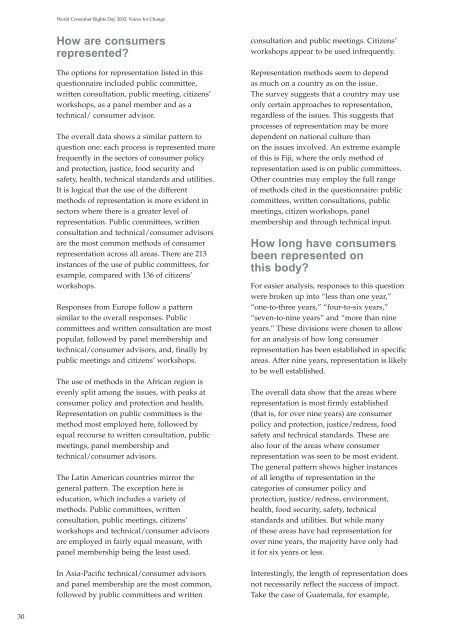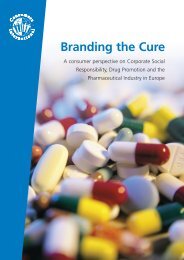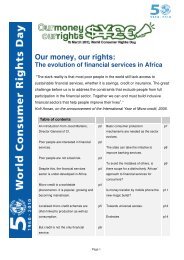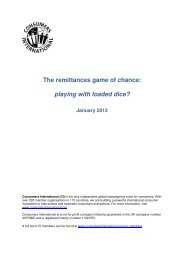Voices for Change: the Consumer Right to Representation
Voices for Change: the Consumer Right to Representation
Voices for Change: the Consumer Right to Representation
You also want an ePaper? Increase the reach of your titles
YUMPU automatically turns print PDFs into web optimized ePapers that Google loves.
30<br />
World <strong>Consumer</strong> <strong>Right</strong>s Day 2002: <strong>Voices</strong> <strong>for</strong> <strong>Change</strong><br />
How are consumers<br />
represented?<br />
The options <strong>for</strong> representation listed in this<br />
questionnaire included public committee,<br />
written consultation, public meeting, citizens’<br />
workshops, as a panel member and as a<br />
technical/ consumer advisor.<br />
The overall data shows a similar pattern <strong>to</strong><br />
question one: each process is represented more<br />
frequently in <strong>the</strong> sec<strong>to</strong>rs of consumer policy<br />
and protection, justice, food security and<br />
safety, health, technical standards and utilities.<br />
It is logical that <strong>the</strong> use of <strong>the</strong> different<br />
methods of representation is more evident in<br />
sec<strong>to</strong>rs where <strong>the</strong>re is a greater level of<br />
representation. Public committees, written<br />
consultation and technical/consumer advisors<br />
are <strong>the</strong> most common methods of consumer<br />
representation across all areas. There are 213<br />
instances of <strong>the</strong> use of public committees, <strong>for</strong><br />
example, compared with 136 of citizens’<br />
workshops.<br />
Responses from Europe follow a pattern<br />
similar <strong>to</strong> <strong>the</strong> overall responses. Public<br />
committees and written consultation are most<br />
popular, followed by panel membership and<br />
technical/consumer advisors, and, finally by<br />
public meetings and citizens’ workshops.<br />
The use of methods in <strong>the</strong> African region is<br />
evenly split among <strong>the</strong> issues, with peaks at<br />
consumer policy and protection and health.<br />
<strong>Representation</strong> on public committees is <strong>the</strong><br />
method most employed here, followed by<br />
equal recourse <strong>to</strong> written consultation, public<br />
meetings, panel membership and<br />
technical/consumer advisors.<br />
The Latin American countries mirror <strong>the</strong><br />
general pattern. The exception here is<br />
education, which includes a variety of<br />
methods. Public committees, written<br />
consultation, public meetings, citizens’<br />
workshops and technical/consumer advisors<br />
are employed in fairly equal measure, with<br />
panel membership being <strong>the</strong> least used.<br />
In Asia-Pacific technical/consumer advisors<br />
and panel membership are <strong>the</strong> most common,<br />
followed by public committees and written<br />
consultation and public meetings. Citizens’<br />
workshops appear <strong>to</strong> be used infrequently.<br />
<strong>Representation</strong> methods seem <strong>to</strong> depend<br />
as much on a country as on <strong>the</strong> issue.<br />
The survey suggests that a country may use<br />
only certain approaches <strong>to</strong> representation,<br />
regardless of <strong>the</strong> issues. This suggests that<br />
processes of representation may be more<br />
dependent on national culture than<br />
on <strong>the</strong> issues involved. An extreme example<br />
of this is Fiji, where <strong>the</strong> only method of<br />
representation used is on public committees.<br />
O<strong>the</strong>r countries may employ <strong>the</strong> full range<br />
of methods cited in <strong>the</strong> questionnaire: public<br />
committees, written consultations, public<br />
meetings, citizen workshops, panel<br />
membership and through technical input.<br />
How long have consumers<br />
been represented on<br />
this body?<br />
For easier analysis, responses <strong>to</strong> this question<br />
were broken up in<strong>to</strong> “less than one year,”<br />
“one-<strong>to</strong>-three years,” “four-<strong>to</strong>-six years,”<br />
“seven-<strong>to</strong>-nine years” and “more than nine<br />
years.” These divisions were chosen <strong>to</strong> allow<br />
<strong>for</strong> an analysis of how long consumer<br />
representation has been established in specific<br />
areas. After nine years, representation is likely<br />
<strong>to</strong> be well established.<br />
The overall data show that <strong>the</strong> areas where<br />
representation is most firmly established<br />
(that is, <strong>for</strong> over nine years) are consumer<br />
policy and protection, justice/redress, food<br />
safety and technical standards. These are<br />
also four of <strong>the</strong> areas where consumer<br />
representation was seen <strong>to</strong> be most evident.<br />
The general pattern shows higher instances<br />
of all lengths of representation in <strong>the</strong><br />
categories of consumer policy and<br />
protection, justice/redress, environment,<br />
health, food security, safety, technical<br />
standards and utilities. But while many<br />
of <strong>the</strong>se areas have had representation <strong>for</strong><br />
over nine years, <strong>the</strong> majority have only had<br />
it <strong>for</strong> six years or less.<br />
Interestingly, <strong>the</strong> length of representation does<br />
not necessarily reflect <strong>the</strong> success of impact.<br />
Take <strong>the</strong> case of Guatemala, <strong>for</strong> example,






![pkef]Qmf eg]sf] s] xf] < - Consumers International](https://img.yumpu.com/6479658/1/184x260/pkefqmf-egsf-s-xf-consumers-international.jpg?quality=85)
